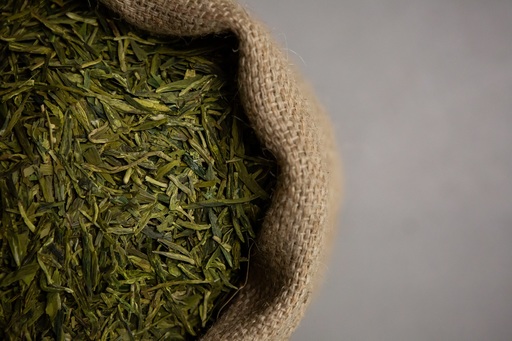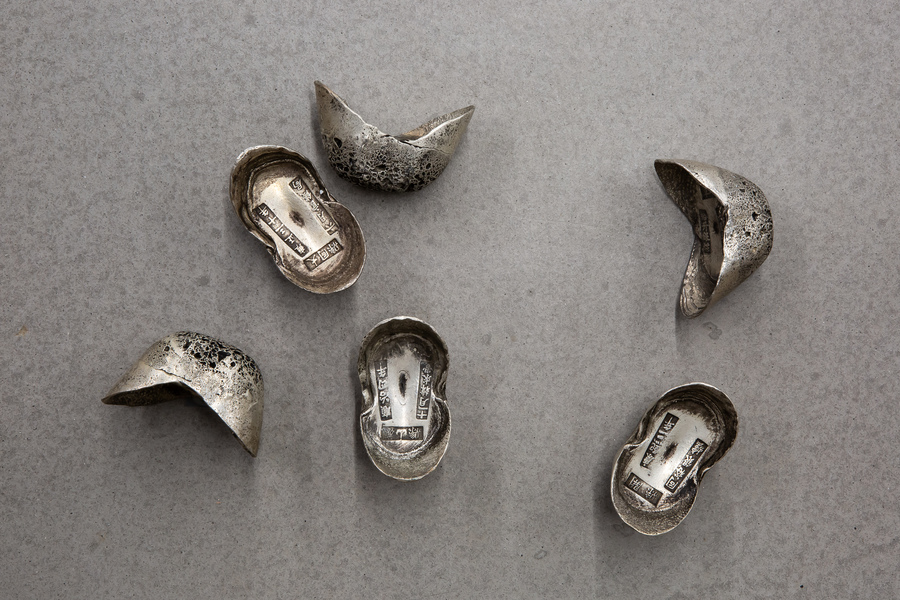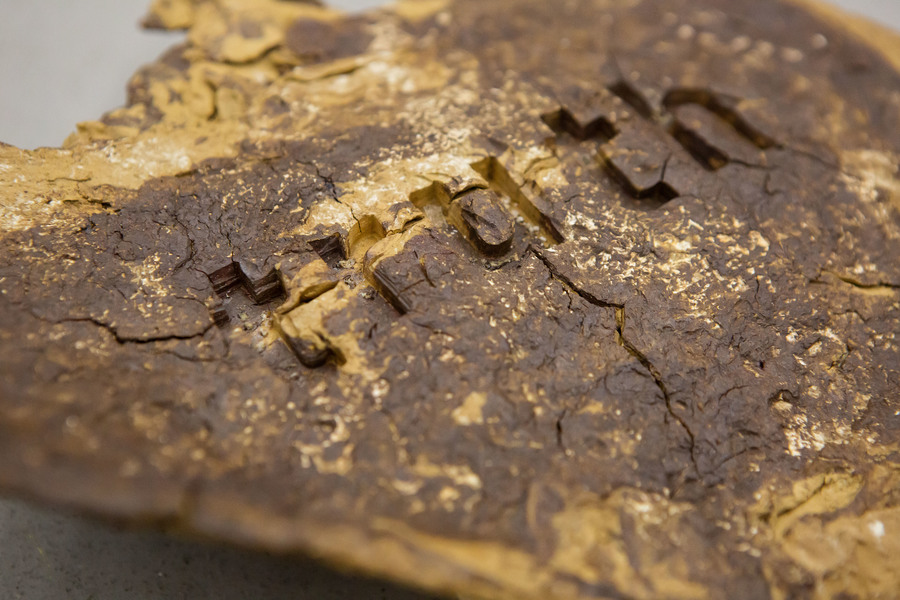Absolute Truth?: Katherine Ka Yi Liu 廖加怡 at Collective, Edinburgh
We meet Katherine Ka Yi Liu 廖加怡 to unpack their new exhibition at Collective, which examines Britain’s colonial legacy in Hong Kong
Katherine Ka Yi Liu’s sculptures are firmly and intentionally anchored to the floor of Collective’s Hillside Gallery space, high above the city of Edinburgh. Formed out of an eccentric array of materials as diverse as tea leaves, rainwater, Hong Kong dollars and cast silver, the Liverpool-based artist and curator formulated the exhibition to be entirely floor-based, to manifest a sense of groundedness and to encourage visitors to meditate on their positionality.
The artist describes the composition of the show as originating from a psychic vision, where they saw a piece of Shān Shuǐ (山水) (traditional Chinese landscape painting) from a bird’s eye view, which encouraged them to adopt a painterly approach to composing the exhibition. For neither the West nor the East can be a determinate location they imagined the gallery floor as a swath of traditional Chinese rice paper. Shān Shuǐ (山水) translates as ‘mountain-water’, and the placement of the sculptures exhibits this joyful fluidity, utilising the objects as if they were ink, the act of painting informing the act of placing.
The artist’s use of materials is intuitive, sculpting writing with the same skill and tenacity as with materials such as Yixing clay. I note the seamless and symbiotic synthesis of writing and physical materials, but the artist says that they do not differentiate between the two in their practice. Using the metaphor of the ‘mycelium network’ (below-ground networks of root-like structures that form between fungi, plants and trees), they emphasise ‘interconnectedness’ and ‘intersectionality’ in regard to the ways they work with and through materials. An investment in writing is also evident in the commissioned text by Glasgow-based visual artist and filmmaker Wei Zhang 喂张 that accompanies the exhibition, a beautiful reflection on the experience of migration, dislocation and the queer body.

Installation view of neither the West nor the East can be a determinate location by Katherine Ka Yi Liu 廖加怡. Photo by Sally Jubb.
While Zhang’s text speaks to this sense of dislocation, the ground-based installation provides a metaphorical weighting to this particular location. The artist looks to the Chinese concept of the ‘Channel Network’, a path through which energies known as ‘qi’ flow, linking this to its counterpart in European theory, the ‘meridian line’. A meridian line runs right through the centre of the exhibition space and onwards towards the observatory in Hong Kong. By highlighting the relationships between the site of the former observatory atop Calton Hill in Edinburgh and the observatory in Hong Kong (built in 1883), the exhibition draws attention to the entanglement of colonialism and astronomy. Observatories were often built in colonial settlements, often on land with spiritual and ecological significance. The ongoing dispute around the American construction of the world’s largest ground-based observatory on the culturally significant and sacred Mauna Kea in Hawai’i evidences the ongoing infringement on to indigenous people’s land.
One of the sculptural works, ‘absolute truth’ (from the beginning of Earth-present) — placed directly on the location where the meridian line passes through the gallery — is a chunk of Yixing clay seemingly broken into two, with one part reading ‘absolute’ and the other one ‘truth’. This humorous, sarcastic gesture could point to the ways in which European settlers attempted to establish their customs, religion and language as the absolute and original truth, erasing indigenous knowledge systems in the process.
The privileging of Western ‘science’ over indigenous knowledge systems became a defining feature of British colonialism, with observatories playing a part in this process of erasure and indoctrination. Indigenous practices of forecasting climatic conditions and changes in the landscape were marginalised, branded as ‘myth’, and replaced by astronomical and meteorological 'technologies' with the primary purpose of facilitating trade between the colony and European nations. Meanwhile, outstanding payment, an assemblage of green tea leaves, Chinese teaware and sterling silver, sarcastically responds to the Treaty of Nanking, which facilitated the British colonisation of Hong Kong. The work also speaks to the debts forced upon nations in the global south in the wake of decolonisation, and the continued absence of reparative justice by European nations.
Of the responses they wish the multisensory installation to elicit, the artist says they want to encourage the audience to practise mindfulness, while simultaneously reflecting on the legacies of colonialism and creating space to unlearn ingrained colonial mentalities. At the same time, Katherine notes how these spaces, including the site of Collective itself, are "spaces where my ancestors were once not allowed nor have never reached", spaces the artist wants to reclaim as part of their wider decolonial practice. The floor-based sculptures eloquently herald this reclamation, staking out a place of sanctuary.
neither the West nor the East can be a determinate location, Collective, Edinburgh, until 26 Feb

